…where east meets west
- Home
- Brief History
- The Greenwich Meridian
- Greenwich
(1675–1958) - Herstmonceux
(1948–1990) - Cambridge
(1990–1998) - Outstations (1822–1971)…
- – Chingford (1822–1924)
- – Deal
(1864–1927) - – Abinger
(1923–1957) - – Bristol & Bradford on Avon
(1939–1948) - – Bath
(1939–1949) - – Hartland
(1955–1967) - – Cape of Good Hope
(1959–1971)
- Administration…
- – Funding
- – Governance
- – Inventories
- – Pay
- – Regulations
- – Royal Warrants
- Contemporary Accounts
- People
- Publications
- Science
- Technology
- Telescopes
- Chronometers
- Clocks & Time
- Board of Longitude
- Libraries & Archives
- Visit
- Search
Telescopes: Flamsteed’s Mast Telescopes and other ‘long’ Refractors
Until the invention of the achromatic doublet in the mid-1700s, refracting telescopes suffered from the distorting effects of chromatic and spherical aberration. In Flamsteed’s time, this was not too serious when making observations of stars, but was problematic when making observations of planets, comets and the satellites of Jupiter. The effects of aberration were reduced by using lenses which were less curved. Such lenses however have longer focal lengths and necessitated the use of long telescope tubes which could be very unwieldy. The longest at Greenwich had a length of 60-feet and was supported by hanging it from a mast.
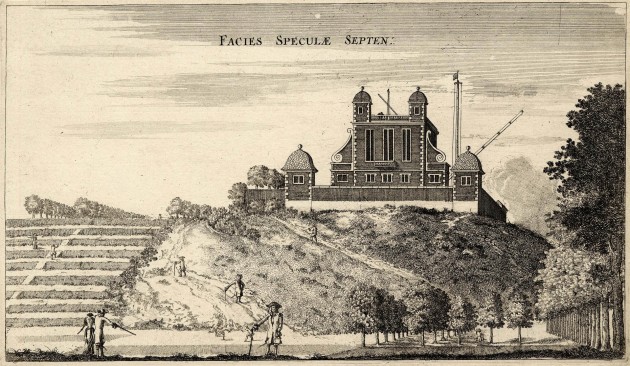
The 16-foot and 60-foot mast telescopes. The mast for the former is mounted on the roof whilst that for the latter is in the garden. In Flamsteed’s time, telescopes were described by their length, rather than by aperture. Etchings by Francis Place after Robert Thacker c.1677–78. © The Trustees of the British Museum (CC BY-NC-SA 4.0). Top: Museum number 1865,0610.948. Bottom: Museum number 1865,0610.949 (see below)
In a letter to Cassini begun on 7 July 1673, Flamsteed wrote (in Latin):
‘I have [in Derby] a telescope 14 English feet long, equipped with plano-convex lenses to which I have applied in connection with the eye-pieces a micrometer or brass machine of Mr. Towneley’s (by the aid of which a single foot is divided into 3507 parts) so that its scales are precisely 13⅔ feet from the object glass; but so that it is possible, as things are now, either to increase or reduce that distance from the eye-pieces by as much as 3 [feet]. ...
However, while making the observations I felt that the movement of the air and wind, by shaking or agitating the tube (which was suspended upon an upright pole in the open air by means of a rope and pulley) was making the observation difficult; rather it frequently prevented me from obtaining very accurate distances. ... After the end of March ... I took care to have a wooden structure like a short ladder fitted in a certain window; by which means the telescope placed on it could be turned in any direction and could not be moved to and fro by the winds, as was the case in the open air, unless they were extremely turbulent.’ (Flamsteed Correspondence Vol.1)
Writing to John Collins a week later on 12 July 1673, Flamsteed gave the following thoughts on some of the equipment he thought should be installed by James Gregory in his new observatory at the University of St Andrews:
‘Telescopes of 2. 3. 7. 14. 30. 40. and fifty foot a peece, the object glasses not to be ground too thick, the eye glasses to be plano-convexes, in the longer tubes 2, joined in theire poles of good breadth, that the 14 foot tube may take in at least 40 min [of arc], and not ground too small a sphere, for tho they would more amplyfe the visible object, they render it lesse distinct; to these must be fitted 2 or More Michrometers.’ (Flamsteed Correspondence Vol.1)
Flamsteed left no detailed description of the ‘Long’ Refractors made only for use at the Royal Observatory, but its seems likely that the same principles applied. Four ‘Long’ Refractors whose focal lengths were nominally 8, 16, 27 and 60 feet are mentioned in the published observations. They were generally referred to by Flamsteed as the 8-foot tube, the 16-foot tube and so on. In addition, Flamsteed also experimented briefly with a 50-foot refractor. In addition, there was at least one occasion when he brought his original 14-foot tube back into use (for an observation of Jovian satellites on 3 Oct 1788). There is also two mentions of an 8½ foot tube (the 8-foot tube?) in the published observations for January 1712. The first mention of the 8-foot and 16-foot tubes seems to come in a letter dated 27 May 1676 sent by Flamsteed to Towneley:
‘I am now providing for the [partial] eclipse [due on 1 June] at which I intend to use a payre of tubes on of 16 the other of 8 foot for measuring the digits eclipsed and parts betwixt the cuspes’ (Flamsteed Correspondence Vol.1)
A gathering took place at the Observatory to both view the eclipse and mark the completion of its construction. Lord Brouncker, President of the Royal Society from its founding in 1662 until 1677 was a guest as was Jonas Moore, Surveyor General of the Ordnance, a fellow of the Royal Society, Flamsteed’s patron, and one of the chief instigators for Flamsteed’s appointment as Astronomer Royal. The King was also expected to attend, though in the event he didn’t.
A letter describing the eclipse dated 10 July 1676 that Flamsteed sent to Oldenburg provides further details about the two telescopes:
‘I had prepared two telescopes: one of 196½ inches [16 feet 4½ inches] long, with which and with Towneley’s micrometer I took measurements of the first eight phases; the other of only 103½ digits [8 feet 7½ inches], with which and with my micrometer he [Halley] took the measurements additional to these.’ (Flamsteed Correspondence Vol.1)
The only mention of the 60-foot tube in the published observations comes in 1677 at which point it seems to have been abandoned. The 27-foot tube is not mentioned anywhere until 1682, suggesting that it may have taken over the role originally intended for the 60-foot tube. Given the presumed slimness of the tube and its great length, one might expect it to have had some sort of bracing to reduce the amount of flexing. Whether it did or not is not known. Nor is it known where it was used. It could have been hung from either the 80-foot mast in the garden or the mast on the roof of Flamsteed House, or used in the Octagon Room, or elsewhere. It is not impossible for it to have been used in different venues at different times.
The ‘Long’ Refractors in the Octagon Room
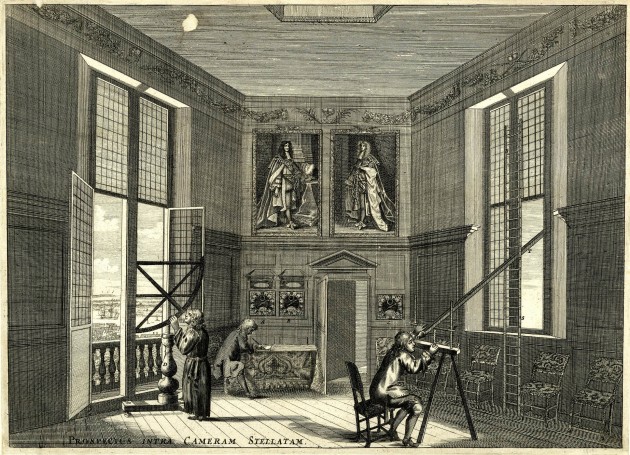
The Octagon Room with an observer at the eyepiece of the 8-foot refractor at the eastern window (right). There does not appear to be a micrometer attached to it. Key: (A) & (B) The two year going Tompion Clocks presented to Flamsteed by Sir Jonas Moore. (C) A further clock about which little is known. (D) 3-foot moveable quadrant. (F) Stand for supporting the eye-end of the telescope tube with a screw mechanism for adjusting its height (S) Ladder for supporting the object-glass end of a telescope tube. (T) the 8-foot telescope tube (with square cross-section). It is not known if there were also ladders attached to the south and west windows or if the ladder at the east window was moved to other locations as required. Etching by Francis Place after Robert Thacker c.1677–78. © The Trustees of the British Museum (CC BY-NC-SA 4.0). Museum number: 1865,0610.952
The first mention of a ‘Long’ Refractor being (or about to be) used there comes in a letter dated 20 December 1675 that Flamsteed wrote to Jonas Moore, while the building was still under construction:
‘As soone as ever I can get things fit to Raise my longer tube in the great roome [Octagon Room] I will use no other, where the phainomenom will come within it, whereby the observations will be more accurate, it being twice as long as that I now use [in the Queen’s House where he was residing while the Observatory was still under construction].’ (Flamsteed Correspondence Vol.1)
The ‘longer tube’ was presumably his 14-foot tube from Derby, which seems to have been largely abandoned by 1776. Whether or not the 16-foot tube was used in the Octagon Room remains to be resolved. Although technically possible for the 27-foot telescope to have been used there, if it was, it would probably have had to be stored outside due to its great length and would have been extremely unwieldy to manipulate into position. We do know however that there were times when both the 16-foot and 27-foot telescopes were in use simultaneously (as on 9 October 1788).
‘Long’ refractors hung from masts and used in the garden and on the roof of Flamsteed House
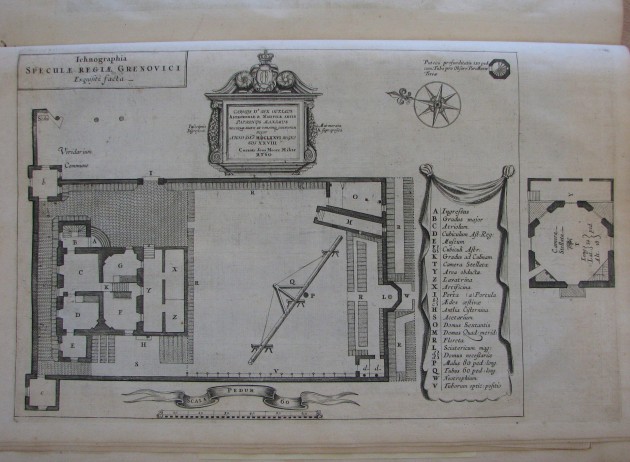
Plan of the Observatory. Key: (P) The 80-foot mast. (Q) The 60-foot telescope (with square cross-section) resting on three trestles on the ground. (V) Storage area for the 60-foot tube. Etching by Francis Place after Robert Thacker c.1677–78. Reproduced by kind permission of Greenwich Heritage Centre from their 'imperfect' copy of of Flamsteed's Historiae Coelestis Libri Duo
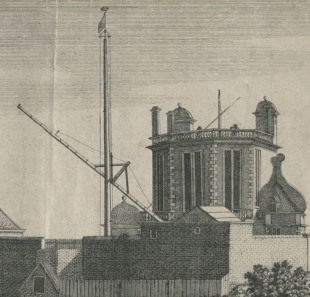
View showing the best detail of how the telescopes were rigged. Etching by Francis Place after Robert Thacker c.1677–78 (detail from Prospectus versus LondiniumProspectus versus Londinium). King George III collection, British Library shelfmark: Maps K.Top.17.1-3.a.1 Digitised and released under a Creative Commons Public Domain Mark (No Known Copyright)
The telescope shown on the Octagon Room roof in the various Place engravings is the 16-foot refractor. This is shown without any bracing and appears to have been raised and lowered by a simpler pulley system with a smaller mechanical advantage as it would have weighed considerably less than the 60-foot tube. As far as can be gleaned from the etchings, there was just one pulley involved at the top of the mast and the rope was attached directly to the telescope.
The arrival of the 60-foot the Mast Telescope
According to Howse (1975), Pepys reported that the Navy Board supplied two or three masts to Moore in March 1676. Hooke indicates in his diary that one of these was erected in the garden on 1 May 1676. Unfortunately Hooke’s writing is very difficult to decipher and the transcription published in 1935 leaves a lot to be desired. The entry appears to say: ‘Sr. J Mo[o]re Eected pole at greenwich.’ What follows is fairly illegible, but according to the transcription it says ‘all the conjurors there’. The original diary page can be viewed here (p.98).
A second entry on 14 June 1677 appears to state ‘A 90 f. glasse from y Parision made without tool. Delivered to Sr. Jon. More.’ This has been transcribed as ‘A 50ft. glasse from the Parisian made without tool.’ Howse (1975) does not appear to have seen the original diary and based his writing about the telescope on the transcription, substituting 60 for 50. In fact, the way Hooke has written the number, it could be interpreted as 50, 60 or 90. It appears on diary page 115. If it says 50 or 60, then it could well have been the object glass for the mast telescope. If on the other hand the number was 90, it was probably the object glass for the Well telescope.
Writing to Oldenburg on 17 August 1677, Flamsteed told him:
‘I hope now by Michaelmas I shall have two glasses one of 50 the other of 60 foot fitted with a tube whereby I may be able to observe what may be remarkable in his [Jupiter’s] face. (Flamsteed Correspondence Vol.1)
It is not clear from this if Flamsteed already had the lenses at the time of writing, of it he was expecting delivery of one or both of them in the next few months.
The 60-foot telescope was not a success and is only mentioned once in the published observations (an observation of Jupiter made on 24 October 1677, when it is described as ‘Turbo pedum 57’, (which Howse (1975) states is recorded as 58 in the manuscript observations). Click here to view the published observation.
A week or so later, Flamsteed wrote to Moore (2 November) and Towneley (3 November) describing how the 50 and 60-foot lenses performed compared to the 16-foot one (Flamsteed Correpondence Vol.1). In the second of these he wrote:
‘I have got the Glasse of 60 foot tried, but find neither in nor Mr Coxes of 48 foot to be in any ways excellent, They show ♃ [Jupiter] large enough but I thinke I see his belts distincter in a 16 foot glasse than in either. I am confident by those observations twhich Mr Cassigny lately imparted that the French glasses excel oures far, how we shall get any better I know not.’
The appears to be the last mention of either a 50-foot or 60-foot telescope at the Observatory.
Decline in use of the telescopes
With each passing decade, the number of published observations made with the telescopes fell by an ever larger percentage. In the first decade there were over 200 published observations. In the fourth (commencing 1706), there were only about 10. No observations where made at all in the five year period 1714–1718 and just one was made the year before and one the year after (which was the last such observation to be made).
The disappearing masts: the conundrum of the contemporary images
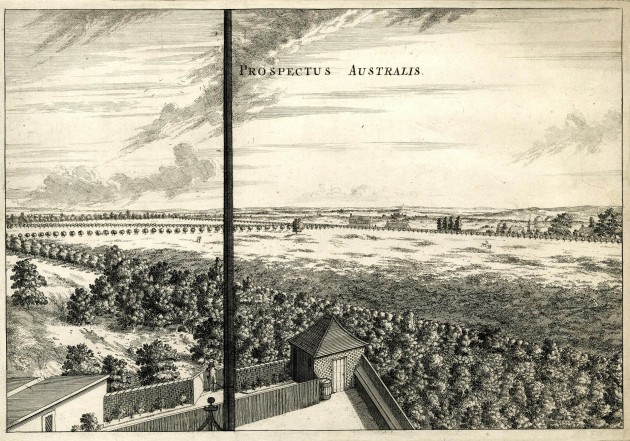
In this view looking south from the Octagon room, the 80-foot mast dominates the scene. The 60-foot tube is absent. Although the object on the ground immediately to the left of the mast has not been identified, it could be associated with the telescope. Etching by Francis Place after Robert Thacker, c.1677–78.. © The Trustees of the British Museum (CC BY-NC-SA 4.0). Museum number: 1865,0610.951
The only known images in which the mast on the roof of Flamsteed House appears are those that form part of the set by Francis Place. They do not for example appear in an oil-painting from the late 1670s showing the observatory from the same viewpoint as the image at the head of the page, despite the fact that the 60-foot mast telescope is shown (Click here to view the painting, which is owned by the National Maritime Museum). It is not known if it was a permanent fixture like the 80-foot mast of it it was something that could be put up and down as required. Given that it was placed somewhere in the middle of the roof it presumably had some kind of a stand on which it stood.
Exactly when the the two masts were (permanently) removed is difficult to tell. Two sketches of the Observatory made by Gasselin in September 1699, (now lost, but previously photographed (RGO 118/ 257 PLQ 5940)) shows neither mast. The same is true of a third sketch by Gasselin dated July 1702 (RGO116/6/3). On the other hand, we know that both the 27-foot and 16-foot telescope were still in ocassional use on these dates.
Four published observations were made with the 27-foot telescope in 1699 prior to Gasselin making his first two drawings. Two further observations were made on 17 March 1700 and 15 June 1701. The 16-foot telescope remained in service for longer, the last published observation being dated 7 March 1706.
The Gasselin drawings have several topographical inaccuracies, but it seems not unreasonable to suppose that the two masts were not present when he drew them. In that case, was Flamsteed making all the observations with the ‘Long’ Refractors in the Octagon Room despite the fact that the 27-foot telescope was hugely oversized for the room or was a temporary mast erected in either the garden or the roof of Flamsteed House when required, for observations with the 27-foot tube and perhaps the 16-foot tube as well? Unfortunatley, we can only speculate. Likewise, we can only speculate when the two masts in the Francis Place etchings were dismounted.
Published observations
Flamsteed’s observations with the ‘Long’ Refractors were published in both the 1712 and 1725 editions of his Historia Coelestis. Most were made with the 8-foot, 16-foot and 27-foot tubes. The 1712 edition covers all Flamsteedt’s observations for the period 1676–1705, whilst the 1725 one covers the years 1676–1719. The pages showing the observations made from 1676–1689 are common to both editions and appear in Book 1 of the 1712 edition and Volume 1 of the 1725 edition. The later observations were published in Book 2 of the 1712 edition without Flamsteed’s approval. In the 1725 edition, Flamsteed organised the later observations not only differently to the 1712 edition, but also in a differently to the 1676–1689 observations. They were published in Volume 2 Click here for a full breakdown of the different sections of the two Historias.
Although the 1725 editions listed below are searchable, finding the observations made with the different ‘Long’ Refractors is easier said than done as it was published in Latin and more importantly, because of the large number of different abbreviations and the inconsistency in the way in which Flamsteed used them – even on the same page. Tube lengths for example were sometimes written in words and sometimes as numerals – sedecim and 16 for example. Pedum (foot) was sometimes abbreviated to ped. and sometimes omitted altogether. The word for tube was sometimes abbreviated from tubo to tub. The following descriptions are also used: tubo longiori and tubo breviore. Sometimes the tube referred to was not one of the ‘Long’ Refractors, but one of the 7-foot tubes of the Equatorial Sextant. Other examples of inconsistency can be found as well. Caveat lector!
The following copies of the 1712 Historia can be viewed online:
Historiae Coelestis Libri Duo (from ETH Zurich)
Historiae Coelestis Libri Duo (from Linda Hall Library)
The following sets of volumes of the 1725 Historia can be viewed online:
From Lyon Public Library
Historia Coelestis Britannica Volume 1
Historia Coelestis Britannica Volume 2
Historia Coelestis Britannica Volume 3
From Ghent University
Historia Coelestis Britannica Volume 1*
Historia Coelestis Britannica Volume 2
Historia Coelestis Britannica Volume 3
* In this copy, some sections are reversed
From the Bavarian State Library
Historia Coelestis Britannica Volume 1
Historia Coelestis Britannica Volume 2
Historia Coelestis Britannica Volume 3
From the National Library of the Netherlands (3 volumes bound as 2)
Historia Coelestis Britannica Volume 1 and part Volume 2
Historia Coelestis Britannica Volume 2 cont. and Volume 3
From National Library Naples (Vol 1 in library catalogue, but seemingly not digitised)
Historia Coelestis Britannica Volume 1
Historia Coelestis Britannica Volume 2
Historia Coelestis Britannica Volume 3*
* In this copy, the preface is not in its usual location
Image licensing
The four images from the British Museum are reproduced under an Attribution-NonCommercial-ShareAlike 4.0 International (CC BY-NC-SA 4.0) license, courtesy of The Trustees of the British Museum. All have been cropped and recompressed for this website. In addition the first image has been partially rotated.
Museum number: 1865,0610.948.
Museum number: 1865,0610.949.
Museum number: 1865,0610.952.
Museum number: 1865,0610.951.
The image digitised by the British Library and released under a Creative Commons Public Domain Mark (No Known Copyright). King George III collection, British Library shelfmark: Maps K.Top.17.1-3.a.1 can be viewed on Flickr.
© 2014 – 2025 Graham Dolan
Except where indicated, all text and images are the copyright of Graham Dolan
